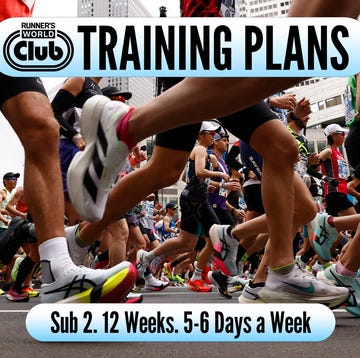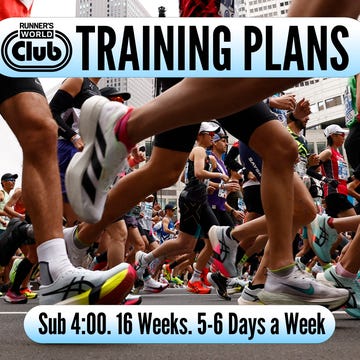Sometimes, it’s nice to have a well-earned break from constant training, sometimes the hiatus is out of your hands due to illness or injury, while at other times, life simply just gets a bit too much. Either way, coming back to running after a break can feel tough and intimidating.
The good news though is that there are ways to manage this and get your running mojo back, from practical steps to ease yourself back in, to clever ways to boost motivation and pointers to reduce the risk of injury. Read on for eight top tips and pieces of advice from running experts that will have you lacing up your trainers and heading for the door.
How to start running again
1. Acknowledge where you’re at right now
First things first: acknowledge that where you’re at physically, after a break, will be different to where you were. Of course, any decrease in fitness will be relevant to the length of time out, but there are several physiological changes that occur when you take a break from running that are worth keeping in mind.
What everyone's reading
Decreased stroke volume (amount of blood pumped from the heart per beat) and cardiac output (the amount of blood pumped from the heart every minute), muscle fibres detraining and tendons and ligaments becoming less flexible are just some of the things that happen to the body when you hang up your running shoes for a while, says Calum Sharma, head of exercise science at The Body Lab. Collectively, these changes impact overall fitness, leading to a decline in aerobic capacity, cardiovascular endurance and muscle performance, explains Sharma. ‘Research suggests that significant decreases in aerobic fitness can occur after just 2-4 weeks of detraining,’ he adds. ‘The longer the break, the more noticeable the decline in fitness.’
There’s also how taking a break can affect you mentally, especially if you use running as a tool to manage mental health, points out Sabrina Pace-Humphreys, running coach, ultra runner and co-founder of Black Trail Runners. ‘That lack of specific training impacts on confidence and can lead to feelings of imposter syndrome when seeking to return,’ she says.
So, the bad news – which can’t be sugar-coated – is that, if you’ve taken a significant break from running you’re going to feel it once you restart. The good news though, is that the more prior running experience an individual has, the quicker they tend to regain their fitness due to muscle memory, says Sharma.
2. Ease yourself back in
‘Be careful of going out too hard,’ warns Pace-Humphreys. Trying to get straight back to a distance or pace you once had nailed is not going to work, she says. ‘You are not the same athlete. I see too many people break themselves trying to regain the running fitness that they once had. It’s the fastest route to injury that there is.’ She also highlights the importance of checking whether your trainers are still fit for use and provide the support you need.
Stick to increasing your mileage by no more than 10 per cent each week, recommends Georgia Malir, running coach and Saucony technical representative. For example, if you run 10 miles one week, then don’t exceed 11 miles the following week. However, Malir stresses the importance of listening to your body: ‘If you are feeling particularly tired one week then do not worry about keeping the mileage the same or [even] decreasing it slightly.’
This is an approach Pace-Humphreys agrees on. ‘I wholeheartedly believe that, when getting back into running, you should ditch the watch and just really dial into the sensation of your own body,’ she says. In her ‘Back to Running’ groups, Pace-Humphreys carries out the following exercise:
- Take it back to basics with a walk/run strategy, such as two minutes of gentle jogging, then one minute of walking for 1-2 miles.
- All the while, listen to your breath and determine where you are on a scale of 1-10 (with one being forever pace and 10 being an all-out effort).
‘This is not about “go hard or go home”. It’s about acknowledging the break you had and the runner you are right now,’ she says.
If you don’t need to start at a walk/run level, Sharma suggests following the FITT principle: frequency, intensity, time and type. So, in practice that would look like 2-3 lower-frequency runs per week at a moderate intensity and of a shorter duration. Then, progressively increase the frequency, intensity, and duration to allow the body to re-adapt without overloading it, says Sharma. The key thing to remember, points out Pace-Humphreys, is to be consistent with your training but also don’t forget to be kind to yourself.
3. Prioritise injury prevention by including strength training
It’s a simple message but one that is often overlooked: increase training volume and intensity gradually to prevent overuse injuries. Sharma advises incorporating dynamic warm-ups and stretching before running. It pays to be cautious of overloading muscles, tendons, and joints too quickly, he says, with common injuries including shin splints, Achilles tendinitis and patellofemoral pain syndrome.
Sharma recommends including strength training exercises targeting key muscle groups like the quadriceps, hamstrings and calf muscles. ‘Strengthening these muscles can help reduce the risk of injury and improve running performance,’ he explains. It’s also worth focusing on the core and glutes and incorporating exercises which mimic the running action.
Pace-Humprheys agrees and calls strength training a ‘must’ for anyone that runs. It doesn’t need to be labour intensive either, she says. ‘It can be as simple as 2 x 20-minute sessions a week, but always get professional advice from a qualified person.’
Ultra runner and UYN ambassador Paolo Venturini, who became the first man to run 39km in the world’s coldest inhabited place (the Republic of Sakha Yakutia, north-eastern Siberia), at a temperature of -52.6°, knows a thing or two about running mentality. His advice for getting back into running after a break? ‘While you may still believe you can run a certain distance or time, having time off will affect this, so make sure you set a new mental goal for what to expect of yourself. If you don’t, and push too hard, you risk doing too much too quickly, and struggling to recover or worse yet – injuring yourself.’
4. Set SMART goals
It’s important to realise and accept when coming back to running, that there is not a one size fits all approach. Setting goals that are specific, measurable, achievable, relevant and time-bound, aka SMART goals, are a great way to personalise your comeback, says Sharma. He recommends utilising technology, such as fitness tracking apps to monitor progress and celebrate milestones. Strava, for example, has a range of running challenges you can sign up for each month with a simple tap and then any running you log goes towards them.
Setting realistic goals for each run or week of training can also be a great way to structure training and maintain motivation, points out Malir. ‘These goals will depend on how much running you were doing prior to your break,’ she explains, adding that some options could be aiming to run three times a week or running 5km continuously without stopping.
While goals can be a useful tool to structure your training, Venturini highlights the importance of periodically re-assessing them. ‘It’s important to set a realistic goal, and be mindful that this can change,’ he says. ‘If you achieve it sooner, then reset the goal. If you get injured, then amend and adjust your timetable.’
5. Incorporate other sports into your training
Sharma, Pace-Humphreys, Malir and Venturini all advocate including cross-training activities, such as cycling, swimming and strength training along with your running programme. Activities that reduce the impact on the body while improving cardiovascular fitness, such as swimming, cycling and aqua jogging, mean you can train more without increasing your risk of injury, says Malir.
In fact, Venturini advises spending 30% of your training time on doing other sports or exercises in the gym. ‘Having a strong core and legs is vital to a good runner as these are the shock absorbers of the body,’ he explains, advising squats and leg curls for building power in your legs.
Opting for non-running activities can also provide a useful mental break, says Pace-Humphreys, plus they can come in useful for maintaining fitness over any further breaks from running.
6. Find a running buddy
If getting back into running after a break can feel daunting, then try pairing up with a pal or going along to a group. Not only will it make the training more social, it’ll also make you accountable. ‘I believe in the power of community [and] of being supported,’ says Pace-Humphreys. Find someone who is in the same boat as you, or has been, and buddy up to share your highs and lows, she suggests. If setting a distance is causing a block, Pace-Humphreys suggests setting a target of ‘time on feet’ instead, thus negating the goal of distance as the driver for increasing fitness.
7. Remember the importance of rest
‘It’s the recovery period between training sessions that the body gets stronger,’ reminds Pace-Humprehys. ‘The session is the stimulus, the recovery is the repair,’ she says, explaining that that is why people who take a few days, or even a few weeks off, can feel stronger when they return. Malir echoes this: ‘It is important to take a break from running occasionally to allow yourself to recover both physically and mentally.’













